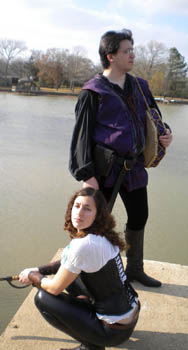Ice & Fire
This song will appear on our upcoming Norse themed CD, Sundown.
Ice and Fire is the Norse creation myth, going from the very beginning of the universe through the creation of all the worlds and species. The story is narrated by the two most important authors of Norse mythological texts, Snorri Sturlson, author of the Prose Edda, and the Seeress who speaks in the Voluspa section of the anonymous Poetic Edda.
(The streaming version below is a preview rough cut from a practice session, which we are sharing in celebration of Sundown’s Balticon debut)
The Seeress of the Voluspa says she remembers the beginning of the world, and can prophecy its end. It is therefore assumed she is likely a giantess, an interpretation reinforced by the fact that she refers to the Aesir in the third person. Her identity is otherwise unclear, but one possible clue is provided in a completely different section of the Edda, “Baldur’s Dream.” This scene (included in the song Sundown) shows Odin’s visit to the grave of a dead Seeress, possibly the same one. Using his ability to breathe life into objects, he revives her in order to question her about the prophecies of Baldur’s coming death. Odin approaches using the alias “Vegtam” and asks her many questions, which she answers. He then asks her a strange question, which still baffles mythographers, roughly translated as, “Who are those three weeping women who throw up the corners of their headdresses into the air?” Hearing him ask this she (somehow) suddenly realizes he is Odin, becomes enraged, and harshly repeats her prophecies of Ragnarok, saying that Loki will escape his bonds and bring about the doom of the gods. Odin accuses her as well, saying, “You’re not the seeress, you’re the mother of three [ogres/monsters].” The story cuts off at this point, but the identification of the prophetess as the mother of three monstrous young can be read as suggesting that she is Angerboda, Loki’s mate, mother of Fenris, Jormungangir, and Hella. I use this reading in my presentation of the Seeress here.
The second narrator, Snorri Sturlson (1179-1241), is one of the most outstanding figures in medieval Icelandic history. The wife of a rival in a lawsuit had attacked Snorri’s father with a knife, declaring “I’ll make you one-eyed like your hero Odin!” and after the attack, in order to prevent a deadly blood-feud between the families, Jón Loftsson, a member of the royal house of Norway, volunteered to make reparations. Instead of money, he volunteered to adopt and raise the victim’s third son, so young Snorri was raised among nobility, and received the very best education. He soon gained a reputation as one of the most learned poets and scholars in the north, and was twice elected Lawspeaker of the Allthing (the only real elected office in Medieval Iceland). He was famed for his encyclopedic knowledge of Viking culture and mythology, and, like any good skald, knew many verses and lists by heart. Later in his life Snorri fell into complicated politics between Iceland and the royals of Norway, who were attempting to assert authority over Iceland. After many daring but unsuccessful political adventures, Snorri took to co-habitating with Hallveig, the wealthiest widow in Iceland. When she died, her sons by her former husband struggled with Snorri over the inheritance. The squabble, fired by political tensions, led to a plot, and Snorri was ultimately assassinated in a night raid. He left behind many histories and poems, a vastly transformed political world, and the Prose Edda, which, though less important at the time of its drafting, is critically important now as one of very few Norse mythological texts to survive.
There are many points in the creation on which the Prose and Poetic Eddas agree, but they do occasionally differ, especially with regard to names. Snorri quotes the Poetic Edda frequently, so he frequently defers to the Seeress throughout the song, but occasionally he interrupts with his own alternatives. The list of names of the Allfather, included in the bridge, provides all the names listed by Snorri in his Edda, while those added as corrections are those which appear only in the Poetic Edda . There are also other names used in other texts, but this song refers only to those used by the two narrators. At the end, when the Seeress becomes angry at Snorri for his interruptions, she alludes to the dark fate that awaits him.
Composer’s Comment: The harmony chant, Ice and Fire, focuses on how fundamentally inimical to life the Norse cosmos is. Everything is made of ice and fire. The gods struggle to carve out a brief world in which life is possible, but the fact that they can do so is miraculous itself, and comes at a great price. The terrible icy Jotuns are the original and natural inhabitants of this grim cosmos, and the world of men is only achieved through their destruction and banishment. In such a cosmos, where great violence was done to carve out a home for more fragile beings like humans, it is only natural that the original forces of deadly ice and fire would wage constant war on life, and that eventually grim Nature will someday overwhelm and destroy it, as a fragile camp on the edge of an icy coast is inevitably swallowed again by storm. Ragnarok is not just the price of the gods’ injustices, but the natural end of things, postponed by the strength and effort of the gods.

